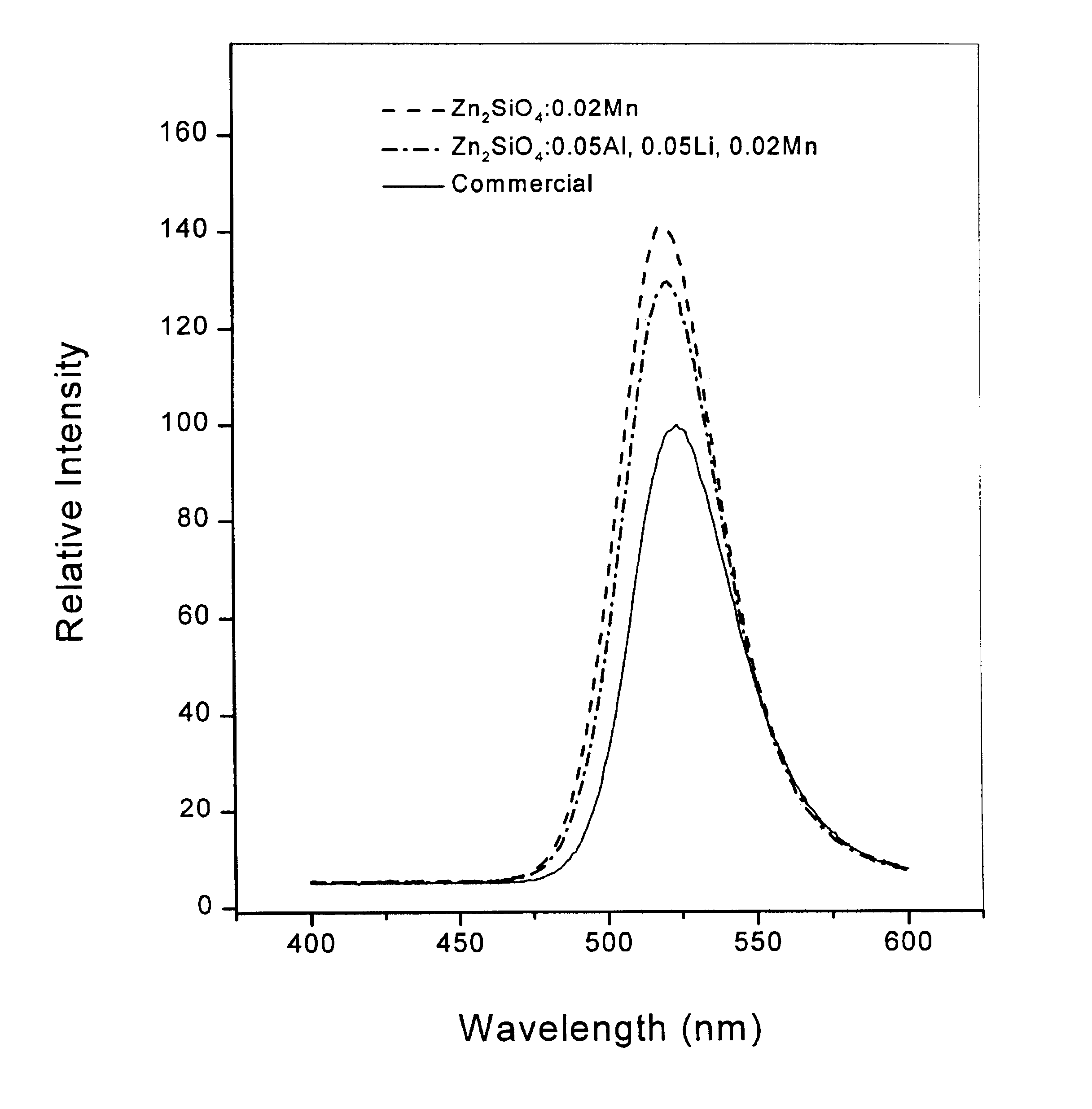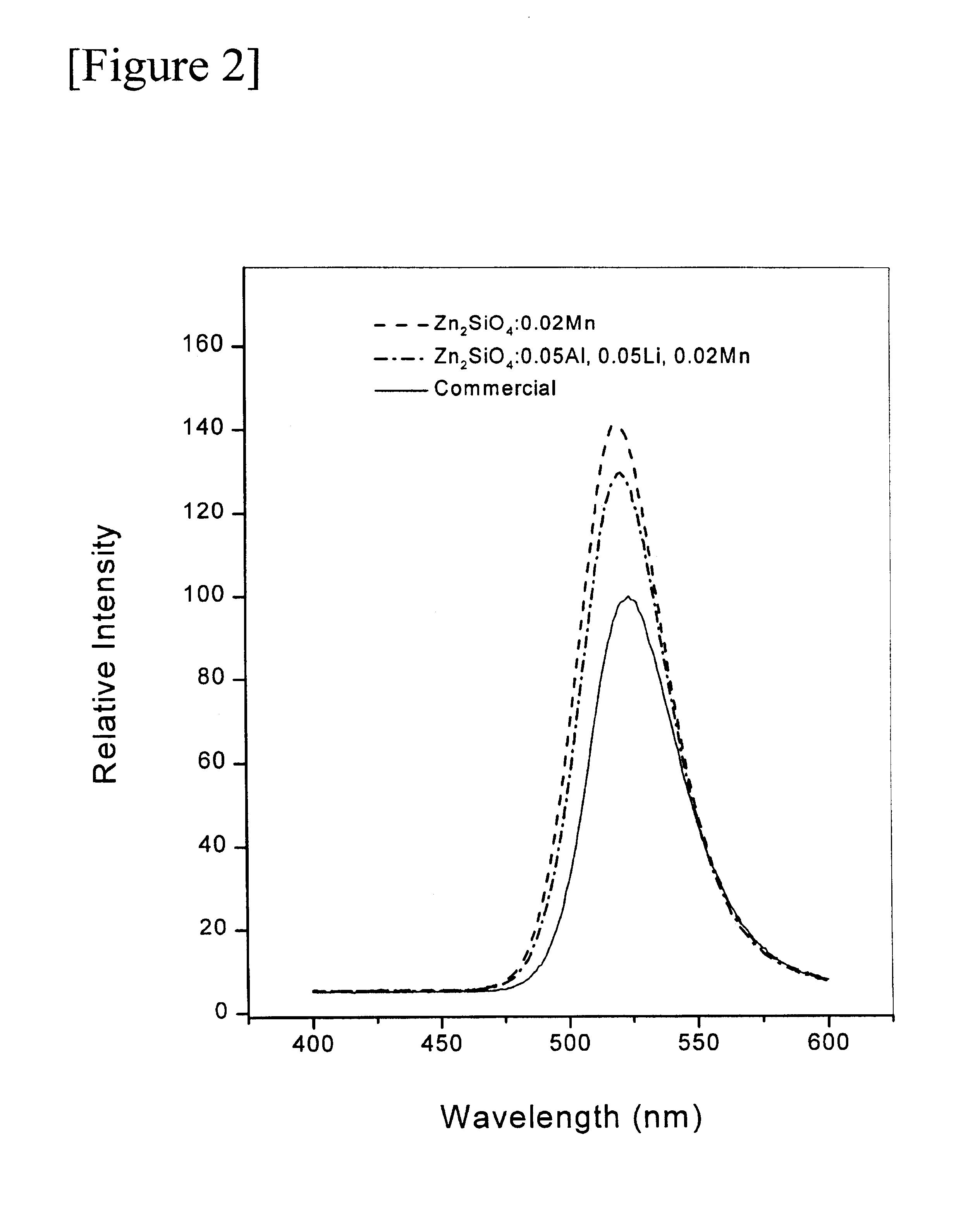Preparing green phosphor based on zinc orthosilicate
a technology of zinc orthosilicate and green phosphor, which is applied in the direction of luminescent compositions, inorganic chemistry, chemistry apparatus and processes, etc., can solve the problems of loss of emission intensity, phosphor particle agglomeration, and methods that have failed to overcome the conventional
- Summary
- Abstract
- Description
- Claims
- Application Information
AI Technical Summary
Problems solved by technology
Method used
Image
Examples
example 2
18.7 g of TEOS was added to 140 mL of ethanol and stirred for 1 hour to generate a TEOS / ethanol solution; then, the solution was hydrolyzed by the addition of 30% of ammonia water (12.6 g) and 14 g of distilled water at 70 for 1 hour so as to precipitate it as a hydrated silica. The precipitate, so filtered off and washed, was transferred to 170.5 mL of 1 mol / L zinc nitrate solution containing 0.00175 mol of manganese nitrate and stirred vigorously for dispersion. 360 mL of 0.5 mol / L ammonium oxalate solution was slowly added to this slurry solution while stirring. By the addition of 50% diethylamine, the pH of this suspension was adjusted to 8 and stirred for 1 hour to form an admixture precipitate containing silicon, zinc and manganese. Hereinafter, the desired phosphor powder was obtained in the same procedure as in Example 1.
The shape of phosphor powder particles, so obtained, had the same spherical form as in FIG. 1b; also, the phosphor powder demonstrated the same green emissi...
example 3
In the same manner as in Example 2, the reaction was performed with an exception that the admixture precipitate of silicon, zinc and manganese formed from 162 mL of 1 mol / L zinc nitrate solution containing 0.00175 mol of manganese nitrate was filtered off; then, the 2.2 mL of 2 mol / L solution containing aluminum and lithium nitrate was impregnated into the admixture precipitate and dried. Hereinafter, the desired phosphor powder was obtained in the same procedure as in Example 1.
The chemical composition of the phosphor, so obtained, was Zn.sub.1.88 Al.sub.0.05 Li.sub.00.5 Mn.sub.0.02 SiO.sub.4. The shape of phosphor powder particles, so obtained, was the same spherical form as FIG. 1b; also, the phosphor powder particles demonstrated the same green emission spectrum centered at 520 nm when excited by vacuum UV ray at 147 nm, as in FIG. 2.
example 4-8
To obtain the phosphors described in the following table 1, the reaction was performed in the same procedure as in Example 2. The test results were shown in the following table 1: a) emission intensity of phosphors measured when excited by vacuum UV ray at 147 nm and decay time (t.sub.10% :time consumed to reach 10% emission intensity with respect to an initial emission intensity) in comparison with the commercially available phosphor.
From the above table 1, it was revealed that when these phosphors, so prepared by Example 1-8 of this invention were compared with the commercially available manganese-activated zinc orthosilicate phosphor, the former had better green emission intensities with uniform particle size and spherical particle shape.
As described above, FIG. 2 is a drawing in which the emission intensities of Zn.sub.2 SiO.sub.4 :Mn and Zn.sub.2 SiO.sub.4 :Al, Li, Mn phosphors, so prepared by Examples of this invention, are compared with that of the commercially available gree...
PUM
| Property | Measurement | Unit |
|---|---|---|
| temperature | aaaaa | aaaaa |
| molar ratio | aaaaa | aaaaa |
| molar ratio | aaaaa | aaaaa |
Abstract
Description
Claims
Application Information
 Login to View More
Login to View More - R&D
- Intellectual Property
- Life Sciences
- Materials
- Tech Scout
- Unparalleled Data Quality
- Higher Quality Content
- 60% Fewer Hallucinations
Browse by: Latest US Patents, China's latest patents, Technical Efficacy Thesaurus, Application Domain, Technology Topic, Popular Technical Reports.
© 2025 PatSnap. All rights reserved.Legal|Privacy policy|Modern Slavery Act Transparency Statement|Sitemap|About US| Contact US: help@patsnap.com



